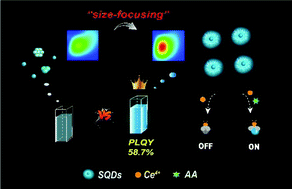Size-focusing results in highly photoluminescent sulfur quantum dots with a stable emission wavelength†
Abstract
Sulfur quantum dots (SQDs) are a new kind of functional nanomaterial, but several challenges still exist in relation to their synthesis and application, such as low-yield and time-consuming synthetic methods, low photoluminescence quantum yields (PLQYs), and the non-selectivity of their detection mechanisms. Herein, we report the drastic enhancement of the fluorescence performance of water-soluble SQDs via the one-pot synthesis of size-focusing QDs using ultrasound microwave radiation. The synthetic period has been greatly shortened to 2 h via the present process. Notably, the proposed SQDs exhibit a highly stable emission wavelength with a record high PLQY of 58.6%. The mechanistic study indicates that size-focusing is a key factor relating to the proposed high-performance SQDs. As they also have robust stability, the proposed SQDs show a wide range of potential applications. Inspired by the characteristic properties of the SQDs and specific analytes, a simple SQD-based fluorescence sensing platform, via a redox-reaction-mediated mechanism, has been successfully developed for the rapid and selective detection of Ce(IV). In addition, this system has been effectively applied to some Ce(IV)-related biological assays, such as ascorbic acid (AA) analysis. This work is an important breakthrough in the SQD field, opening up avenues for solving the challenging problems relating to SQD-based probes, enriching the fundamental understanding of them, and greatly extending their applications, especially in biomedicine.



 Please wait while we load your content...
Please wait while we load your content...